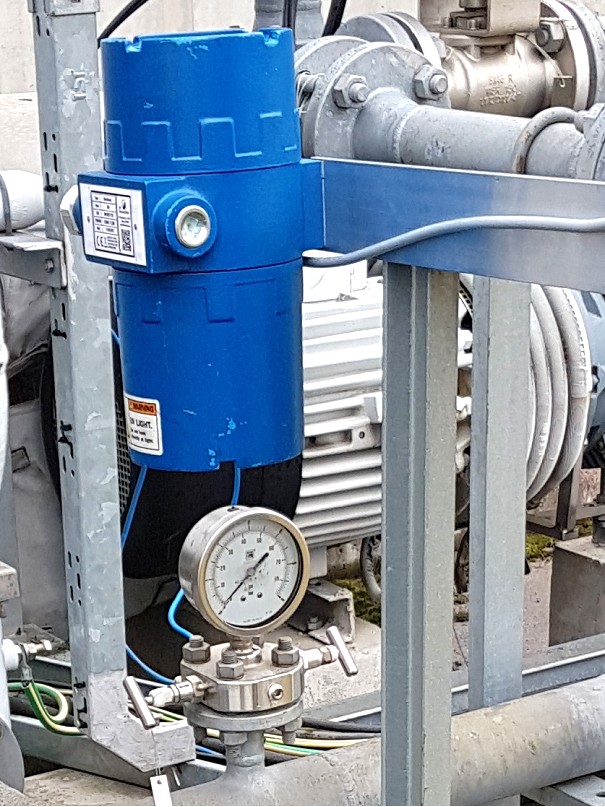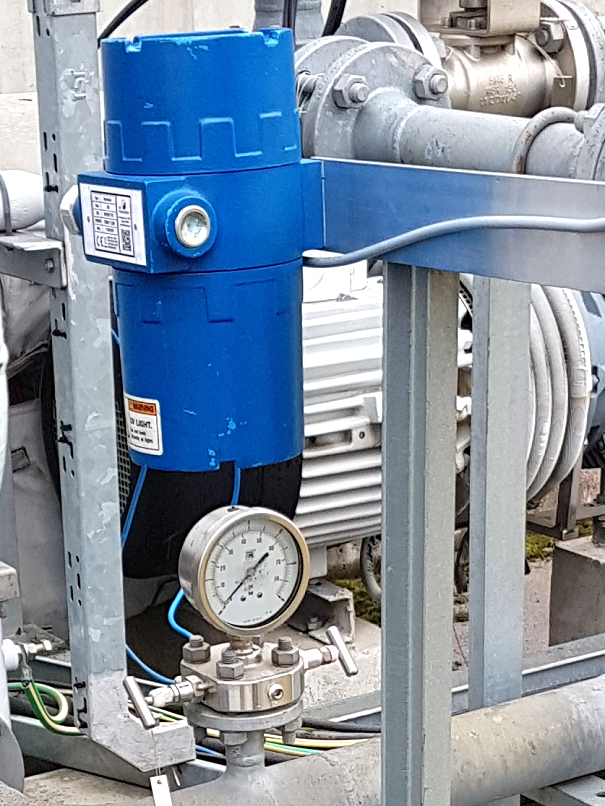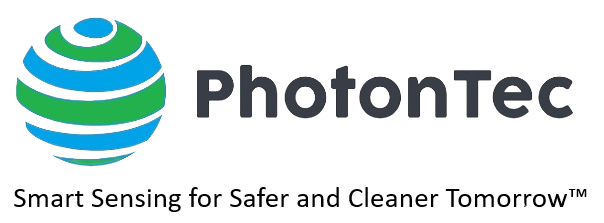HAWK SENSOR SERIES
Advanced Hawk sensors offer real-time, contactless remote detection of oil and fuel releases, hydrocarbon contamination in water, and harmful algal blooms (HABs) for various industrial and environmental monitoring applications.
Patented and versatile Coaxial Fluorometric Remote Sensing (CFRS) technology creates a new monitoring solution, enabling non-invasive detection in challenging applications on both dry surfaces and water, from fixed to mobile monitoring
scenarios.
EFFECTIVE OIL & FUEL DETECTION
Hawk Hydrocarbon Sensors detect a wide range of liquid hydrocarbons, from crude oil to heavy and light intermediates and finished refined products, delivering high sensitivity, extensive 33+ ft detection range, and coverage for both
small & large areas.
Hawk sensors excel in monitoring intricate dry surfaces, operating reliably in turbulent waters and areas with fluctuating water levels. They provide real-time alerts and continuous data for informed decision-making and rapid
response.
NON-CONTACT ALGAE MONITORING
BlueHawk Algae Sensors continuously monitor, identify, and quantify both freshwater and marine cyanobacteria (blue-green algae) and green algae in water, based on chlorophyll, phycocyanin, and phycoerythrin pigment level measurements.
The non-contact CFRS technology provides reliable and maintenance-free operation with no biofouling, making the sensors ideal for long-term monitoring of reservoirs and intakes, industrial water systems, lakes, bays, estuaries, and
rivers.
Where Our Sensors Can Enhance Safety and Protection: On Land, Water & More










Principle of Operation
Hawk sensors utilize fluorometry, a technique that uses light to detect specific molecules based on their fluorescence properties.
Depending on the application, the sensors project pulses of ultraviolet (UV) or visible light onto the monitored surface. When this light interacts with hydrocarbons found in crude oil and petroleum products, photosynthetic pigments
in cyanobacteria and green algae, or fluorescent components within CDOM, it triggers the emission of fluorescent light at distinct wavelengths. The sensors then detect this fluorescence and measure its intensity, which is proportional
to the amount of the target substances present. The greater the presence, the stronger the signal.
Upon reaching a user-defined threshold, the sensor triggers an alarm and/or sends a notification for response. It can also continuously transmit real-time monitoring data to control systems or software applications via wired/wireless
connections.


Patented CFRS™ Technology
Powerful Non-Contact Remote Monitoring
Wide Range of Detectables: Liquid Hydrocarbons (Crude to Naphtha), Harmful Algal Blooms & More
Hawk sensors offer exceptional versatility in detecting a wide range of liquids and contaminants. This includes oils, fuels, and other petroleum products, green and harmful algal blooms (HABs), and colored dissolved organic matter (CDOM).
The sensors utilize both ultraviolet A (UVA) and ultraviolet B (UVB) wavelengths to detect a broad spectrum of liquid hydrocarbons. UVA excels at detecting crude oil and heavier petroleum products like fuel oils, lubricants, heating oils, and hydraulic oils.
However, UVA and conventional UVA-only sensors have limitations. They struggle to detect or completely miss lighter refined products like gasoline, jet fuels, and naphtha. This is where UVB technology comes in. It provides a significant advantage by effectively detecting these lighter products.
UVA is also used to detect CDOM, a naturally occurring organic material found in water.
Hawks leverage multiple select wavelengths in the visible spectrum to maximize sensitivity and accuracy for targeted algal pigments and corresponding blooms.
Our sensors may also be able to detect other products like solvents, coolants, cleaners, pesticides, herbicides, and fluids with UV tracers or dyes. Please contact us to discuss the feasibility and explore the most suitable solution for your specific needs.
Continuous Non-Contact HABs Monitoring: Chlorophyll, Phycocyanin & Phycoerythrin
Harmful algal blooms (HABs) are large accumulations of algae that can produce toxins, disrupt aquatic ecosystems, and cause problems for drinking water supplies, industrial operations, and recreational waterbodies.
BlueHawk Algae Sensors continuously monitor and quantify targeted blue-green (cyanobacteria) and green algae in fresh and saline waters by analyzing the levels of specific photosynthetic pigments within these organisms.
Each sensor is configured for the target algae and corresponding pigments. Chlorophyll, found in all algae, serves as a baseline measurement for overall algal activity. Additional pigments can be used for more specific identification: Phycocyanin reveals the presence of freshwater or marine cyanobacteria, and detecting phycoerythrin pinpoints the presence of marine blue-green algae specifically.
By using a combination of chlorophyll and these additional pigments, BlueHawk Algae Sensors provide a more comprehensive picture of algal activity and type in the waterbody than chlorophyll-only monitoring.
Additionally, a BlueHawk CDOM Sensor can be deployed to monitor colored dissolved organic matter in surface waters by measuring the level of its fluorescent components.
Hawks’ non-contact detection method eliminates the need for physical contact with the water, resulting in virtually maintenance-free operation with no biofouling.
Exceptional Performance: CFRS Technology for Reliable Detection on Land and Water
Hawk’s unique and patented LED-based coaxial optical design offers significant advantages over conventional sensors. It allows for reliable monitoring of water, wet surfaces, and dry surfaces like concrete, metal, soil, and ice – regardless of their shape or orientation. This makes Hawks ideal for monitoring flat and uneven surfaces, equipment with intricate geometries, and industrial, municipal, and natural water systems. They are also well-suited for detecting hydrocarbons in process waters, cooling waters, condensate, produced waters, and wastewaters.
CFRS sensors’ large lenses and apertures offer efficient light delivery and improved signal-to-noise ratio, boosting sensitivity to detect low to high levels of hydrocarbons and algae, while minimizing false alarms.
Continuous built-in self-diagnostics, light source status monitoring, and LED power compensation functions ensure peak performance in any conditions.
High pulse rates enable Hawk sensors to operate five times faster than traditional sensors, making them ideal for monitoring choppy, turbulent, and fast-moving waters.
The result: Hawks enable reliable monitoring in many applications where traditional methods fall short.
Extensive Range & Broad Detection Angle: Flexible Deployment for Stationary or Mobile Monitoring
With an up to 33+ ft (10+ m) detection range, Hawk installations are designed for minimal disruption. The sensors can be mounted on close or distant platforms like water intake towers, embankments, dams, piers, bridges, deep sumps, fuel hydrant systems, loading/unloading racks, storage tanks, and other structures within industrial facilities. They can also be deployed on vessels, vehicles, and aerial drones for mobile monitoring.
Hawk CFRS sensors are highly adaptable to varying surface distances, ensuring reliable water monitoring in industrial settings and areas with high waves or large tidal variations.
An exceptionally wide detection angle (±45°) expands deployment options in environments where perpendicular installation is difficult or impossible. This also allows pairing the sensor with a pan-tilt mount for continuous scanning of large areas and surfaces up to 1,600 sq ft (150 m²).
Additionally, the broad detection angle enhances monitoring coverage on complex surfaces of intricate equipment and improves accuracy in dynamic environments such as turbulent or fast-flowing waters with constantly changing surface topography.
Compact Design, Low Power Consumption, and Built for Tough & Hazardous Environments
Leveraging the advancements in optics and electronics, Hawk sensors achieve remarkable compactness, lightweight design, and minimal power consumption. This makes them ideal for deployment in space-restricted and power-limited environments, such as cramped sumps, remote monitoring stations, buoys, aerial drones, and other battery or solar-powered applications.
Hawk sensors feature IP68-rated enclosures, providing robust protection in demanding environments and resistance to temporary submersion.
Optionally, HazLoc (Class I/II/III, ATEx) enclosures are available for deployment in hazardous locations with flammable gases, vapors, liquids, or combustible dust. This makes them suitable for industries like oil and gas, petrochemical, chemical, and mining.
Built to endure the harshest conditions, Hawk sensors deliver reliable and virtually maintenance-free monitoring for years to come.
Flexible Connectivity, Scalable Monitoring, and Customizable Options
User-friendly software allows for remote access and sensor configuration directly from your desk or control center. Versatile connectivity options, including wired connections and various wireless methods like cellular or satellite modems, or low-power wide-area network (LPWAN), enable transmission of real-time monitoring data and alarm notifications. This IoT-ready system thus empowers users with efficient data management, real-time insights, and global accessibility.
Hawk sensors can operate independently or integrate into easy-to-expand multi-sensor networks. They can also integrate with SCADA and other industrial automation and control systems, and environmental monitoring networks. To verify compatibility, please contact us to discuss required communication protocol and data format.
Hawks offer optional features to enhance functionality for specific needs. With optional surface distance measurement, the BlueHawk can further improve detection accuracy across its entire sensing range, amidst widely fluctuating water levels, for example. Additionally, Hawks can be equipped with a data logger for recording the sensors’ digital output, allowing for historical data analysis even when offline from the main network.
BlueHawk™ and TinyHawk™ Sensors
Advanced Multi-Surface Contaminant Monitoring
BlueHawk CFRS Family: Our Flagship Sensors
BlueHawk CFRS (Coaxial Fluorometric Remote Sensing) sensors are ideal for applications that require long sensing ranges or the ability to detect and monitor hydrocarbon leaks, spills, presence in water, and algal blooms over a wide range of sensor-to-surface distances. This makes it well-suited for non-invasive monitoring at industrial facilities, on land, in turbulent, high wave, and large tidal water environments, and onboard drones or vessels. Additionally, BlueHawk can measure CDOM (colored dissolved organic matter) in water, and all BlueHawk sensors can be installed on pan-tilt mounts for large-area monitoring.
KEY SPECIFICATIONS:
Monitored surfaces: Any dry, wet, flat, uneven, complex, or non-horizontal surfaces; stationary to choppy, turbulent, and fast-moving waters.
Detectable hydrocarbons: Wide range of liquid hydrocarbons from crude oil to refined intermediates and heavy, midweight, and light finished products including fuel oils, lubricants, heating oils, hydraulic oils, diesel, jet fuels, and gasoline.
Detectable algae: Freshwater & marine cyanobacteria (blue-green algae) and green algae using chlorophyll, phycocyanin, and phycoerythrin pigment level measurements.
Detectable CDOM: Colored dissolved organic matter in fresh and saline waters through fluorescent component measurement.
Light source: LED with self-diagnostics and power compensation functions
Operational wavelength bands: UVA / UVB / Vis
Detection range: 3 to 33+ ft (0.9 to 10+ m)
Coverage: Up to 1,600 sq ft (150 m²) on pan-tilt mount. Unlimited when mounted onboard a drone, vessel, or vehicle.
Sensitivity: Sub-μm / sub-ppm, adjustable
Detection/installation angle: Up to ±45° from perpendicular to surface
Pulse rate: Adjustable, up to 10 Hz
Enclosure: IP68 standard, HazLoc (Class I/II/III, ATEx) available
Size (Standard): Ø 4” x 9.4” (Ø 10 cm x 24 cm)
Weight (Standard/HazLoc): 3.0 lb / 10.8 lb (1.4 kg / 4.9 kg)
Power: 10-30 VDC, 2 W
Optional features: HazLoc (Class I/II/III, ATEx) enclosure, Surface distance / Water level measurement, Wired or Wireless data transmission and alarms, Stand-alone or Networked operation, Data logger

TinyHawk: Compact Design, Advanced Performance
Optimized for closer-range hydrocarbon monitoring (up to 10 ft / 3 m) on static surfaces, TinyHawk combines reliability with minimal size, weight, and power consumption in a cost-effective package.
KEY SPECIFICATIONS:
Monitored surfaces: Any static surfaces such as concrete, metal, soil, stationary or slow moving water, ice, etc., where the distance between the sensor and the surface remains relatively constant.
Detectable hydrocarbons: TinyHawk can detect a wide range of liquid hydrocarbons from crude oil to refined intermediates and heavy, midweight, and light finished products including fuel oils, lubricants, heating oils, hydraulic oils, diesel, jet fuels, and gasoline.
Light source: LED with readiness for self-diagnostics and power compensation functions
Operational wavelength bands: UVA / UVB
Detection range: 0.7 to 10.0 ft (0.2 to 3.0 m)
Sensitivity: Sub-μm / sub-ppm, adjustable
Detection/installation angle: Up to ±45° from perpendicular to surface
Pulse rate: Adjustable, up to 10 Hz
Enclosure: IP68 standard, HazLoc (Class I/II/III, ATEx) available
Size (Standard): Ø 4” x 3.5” (Ø 10 cm x 9 cm)
Weight (Standard/HazLoc): 1.5 lb / 5.5 lb (0.7 kg / 2.5 kg)
Power: 12-35 VDC, 1.5 W
Optional features: HazLoc (Class I/II/III, ATEx) enclosure, Wired or Wireless data transmission and alarms, Stand-alone or Networked operation, Data logger













About PhotonTec™
Smart Sensing for Safer and Cleaner Tomorrow™
Your Partner for Hawk Sensor Technology
PhotonTec’s founders bring over 30 years of optical imaging and sensing expertise to your industrial and environmental monitoring needs. Based in Atlanta, GA, we specialize in fluorometric sensors for hydrocarbon and algae detection, leveraging our deep knowledge in optical and photonic technologies – from IR sensing to 3D machine vision and AI-driven inspection systems.
As the authorized U.S. and Mexico representative for the BlueHawk and TinyHawk sensor series, we provide comprehensive sales, application support, and technical services. Our team ensures seamless deployment and expert guidance for industrial and environmental monitoring applications.
Technology Development
Our sensors are engineered and manufactured by LDI Innovation Ltd, whose team also brings over 30 years of photonics expertise. A European leader in optical technologies established in 2013, their ISO 9001:2015 certified facility combines state-of-the-art optics and electronics expertise to develop proprietary patented technologies for critical sensing and monitoring applications, trusted by leading organizations worldwide.

We’d Love to Hear from You
We’re here to help! Whether you’re interested in Hawks’ features, exploring applications for your operations, requesting product documentation, scheduling a free demo, conducting feasibility tests with your samples, or making press inquiries – we’re ready to answer your questions.
Contact us using the form below or by:
Phone: +1 (770) 366-4137
Email: info@photontec.net
Website: www.photontec.net
Location: Atlanta, GA, USA (Eastern Time)
